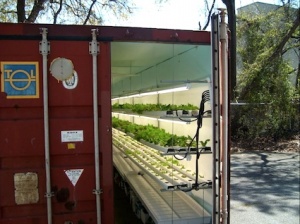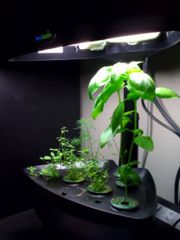Food/Controlled Environment Agriculture
Aeroponics is the art of growing plants with their roots in air rather than in soil. The roots are intermittently spraying with nutrient-enriched water. This allows for precise control of the amount of nutrients that the plants receive.
The figures on Wikipedia show that growing plants hydroponically (with their roots in nutrient-enriched water) results in yields 50% to over 1700% higher than growing in soil. Aeroponics yields are higher yet [1] [2].
show that growing plants hydroponically (with their roots in nutrient-enriched water) results in yields 50% to over 1700% higher than growing in soil. Aeroponics yields are higher yet [1] [2].
By growing aeroponically indoors, we can create an environment that can be monitored and controlled electronically. This lends itself readily to automation. A controlled environment allows food to be grown year-round, independent of seasons. While only one harvest a year can be grown conventionally, constant-yield growth gives 4-30 harvests a year, depending on the plant. Growing indoors greatly reduces the threat of pests and plant-diseases, eliminating the need for pesticides. And best of all, by optimizing the nutrient flow, we can supply plants with the nutrients they need to produce the flavonoids that give them their flavour. With controlled growing, it is possible to achieve a more intense flavour than growing in soil.
Aeroponics requires an input of water with dissolved mineral salts, but it uses these resources very efficiently. Hydroponics uses only 5-10% the water of agriculture [3], while aeroponics uses 65% less water than hydroponics and only a quarter the nutrients [4]. Such water-efficient growing will make huge difference if we want to preserve our water resources, as 69% of all our water use is for agriculture [5]. Both of the necessary inputs for aeroponics - water and minerals - are in enormous abundance on Earth.
LEDs can efficiently satisfy the light requirements of plants. Experiments by the University of Manitoba found that LED lighting increases yields by about 40% [6]. LEDs could be useful in situations where sunlight is unavailable - such as in winter in regions far from the Equator, in underground or underwater dwellings, in cities where a demand for space means food must be grown on stacked shelves indoors, and in space habitats. Currently the main obstacle to large controlled-environment agriculture projects such as The Vertical Farm Project is the cost of energy for lighting. As LEDs become cheaper and more energy-efficient (as with recent developments in OLED and PHOLED technology) these projects become more and more feasible. Fibre-optic cables can pipe sunlight in from outdoors, significantly reducing the amount of energy needed.
Omega Garden uses an innovative cylindrical design in which plants are constantly tilted so they have to adjust to gravity[7]. It is claimed that this method can result in a fivefold increase over other plants grown in the same conditions but without rotation.
There are many tricks that can be used to increase yield in controlled-environment growing that are not feasible on farms. Increasing carbon dioxide concentration in the air can increase yield 30-50%. Supplementing with fulvic acid can increase yield over 30%. Plant hormones such as gibberellin increase yields significantly.
Even with none of these tricks, a hydroponic garden can regularly grow 2kg of vegetables a day (more than enough to nourish a person) in 20 square meters [8]. An aeroponic garden using LEDs, CO2, plant hormones and fulvic acid could grow the same amount in perhaps half the space. Furthermore, it is possible to stack five layers of crops one on top of another in a 2m high system, reducing footprint fivefold. The surprising result is that in the near future, city-dwellers will be able to grow most or all of their own food in their kitchen - farming will not be necessary for food-production. Space colonists could also grow food locally using aeroponics and in-vitro meat.Dickson Despommier, an advocate of vertical, controlled-environment farming, has painted a picture of what controlled-environment growing might be like -

"Each floor will have its own watering and nutrient monitoring systems. There will be sensors for every single plant that tracks how much and what kinds of nutrients the plant has absorbed. You'll even have systems to monitor plant diseases by employing DNA chip technologies that detect the presence of plant pathogens by simply sampling the air and using snippets from various viral and bacterial infections. It's very easy to do.
Moreover, a gas chromatograph will tell us when to pick the plant by analyzing which flavenoids the produce contains. These flavenoids are what gives the food the flavors you're so fond of, particularly for more aromatic produce like tomatoes and peppers. These are all right-off-the-shelf technologies. The ability to construct a vertical farm exists now. We don't have to make anything new."
Algorithms could be developed and shared online to model how nutrient flow, timing, duration, intensity and color of light, and strains of plants used affects food yields and flavour. PlantLab is a company that is compiling exact, programmable specifications for growing various plants, but open-source methodology has proven to be a much faster way of compiling large streams of experimental data. Programming these algorithms into computers that control the LED lights and the nutrient flow in the aeroponic system would yield a truly automated food-production system that anyone could use to grow their own food indoors. All this technology exists currently, and is being constantly improved and refined.

